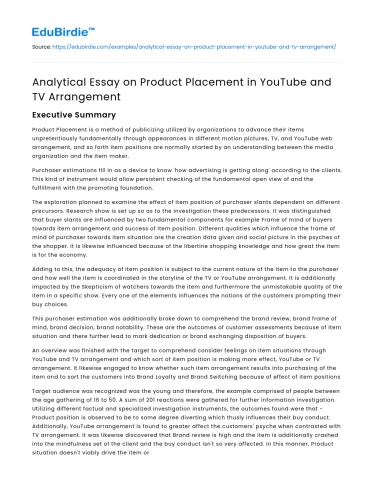Introduction
In the evolving landscape of advertising, product placement has emerged as a strategic tool for marketers aiming to subtly embed their products within the entertainment content consumed by audiences. This advertising strategy leverages the power of association, whereby products are integrated into media content, potentially enhancing brand recall and favorability among viewers. With the rise of digital platforms, particularly YouTube, alongside traditional television, product placement has adapted to the distinct environments these mediums offer. This essay examines the nuances of product placement in both YouTube and television, assessing its effectiveness, ethical considerations, and the varying reception from audiences. By critically analyzing specific case studies and existing literature, this essay aims to provide a comprehensive understanding of how product placement functions across these platforms, highlighting its impact on consumer behavior and the broader implications for the advertising industry.
Product Placement in YouTube: A New Frontier
YouTube, as a dynamic platform, presents unique opportunities and challenges for product placement. Unlike traditional television, YouTube content creators often enjoy a more personal relationship with their audience, which can lend authenticity to the products they endorse. For instance, a study by Smith et al. (2020) highlights that viewers are more likely to trust product placements in videos by creators they follow regularly, due to the perceived authenticity and relatability of the creator. This relationship allows for a seamless integration of products into content, which can result in higher engagement and conversion rates.
Save your time!
We can take care of your essay
- Proper editing and formatting
- Free revision, title page, and bibliography
- Flexible prices and money-back guarantee
However, the informal nature of YouTube also introduces ethical concerns. The Federal Trade Commission (FTC) mandates clear disclosure of paid promotions, yet this is not always adhered to, leading to potential deception of viewers. A notable example is the controversy surrounding YouTube influencers who failed to disclose sponsorship deals, sparking debates on transparency in digital advertising. Critics argue that undisclosed product placements exploit the trust between creators and their audience, leading to calls for stricter regulations. Nonetheless, when executed transparently, product placement on YouTube can be an effective tool for brands, as exemplified by campaigns such as the collaboration between beauty brand Morphe and influencer James Charles, which led to a significant increase in sales and brand visibility.
Product Placement on Television: Tradition Meets Innovation
Television remains a powerful medium for product placement, albeit one facing challenges from digital competitors. Traditional TV shows and films have long utilized product placement to enhance realism and offset production costs. A classic example is the placement of Reese's Pieces in the movie "E.T. the Extra-Terrestrial," which reportedly increased the candy's sales by 65% (Russell & Belch, 2005). Such placements benefit from the high production values and broad reach of television, often resulting in memorable brand associations.
Despite its advantages, television product placement faces criticism for its intrusive nature. Viewers may perceive blatant product insertions as disruptive, potentially leading to negative brand associations. To counteract this, advertisers have adopted more subtle integration techniques, such as embedding products into storylines or using them as props, which can enhance narrative authenticity without overt commercialization. Furthermore, with the advent of on-demand streaming services, advertisers have begun experimenting with interactive product placements, allowing viewers to engage directly with the advertised products. This innovation signifies an evolving approach, blending traditional practices with digital interactivity to enhance viewer engagement and brand recall.
Balancing Effectiveness and Ethics in Product Placement
While product placement offers significant advantages in terms of brand exposure and consumer engagement, it also raises ethical questions concerning transparency and consumer autonomy. Critics argue that product placement blurs the line between content and advertising, potentially manipulating viewer perceptions without their informed consent. This concern is particularly pronounced on platforms like YouTube, where the distinction between personal content and commercial promotion can be ambiguous.
To address these issues, industry stakeholders must prioritize transparency and ethical considerations. Clear labeling of sponsored content and adherence to regulatory guidelines are essential to maintain consumer trust and uphold the integrity of content. Moreover, as audiences become more media-savvy, they demand greater authenticity and honesty from both creators and brands. This shift necessitates a reevaluation of product placement strategies to ensure they align with evolving consumer expectations.
Conclusion
In conclusion, product placement remains a potent advertising strategy across both digital and traditional media landscapes. While YouTube offers a novel avenue for personalized and authentic endorsements, television continues to capitalize on its broad reach and production quality. However, both mediums face the challenge of maintaining ethical standards and transparency to safeguard consumer trust. As the advertising industry continues to evolve, it is imperative for marketers to strike a balance between creativity and ethics, ensuring that product placements resonate with audiences without compromising their autonomy. By embracing transparent practices and adapting to changing consumer preferences, product placement can continue to be a valuable tool in the marketer's arsenal, effectively bridging the gap between brands and audiences.






 Stuck on your essay?
Stuck on your essay?

